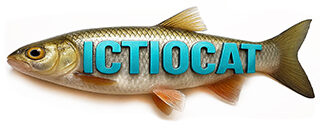Degradació ambiental
Els peixos, com la resta d’organismes que viuen als ecosistemes fluvials, estan influenciats per quatre variables principals: qualitat de l’aigua, règim de cabals, nutrients i estructura de l’hàbitat. Els canvis causats per l’acció humana en qualsevol d’aquestes variables influiran sobre les comunitats de peixos.
Els canvis més importants poden produir efectes quantitatius immediats, com una mortaldat de peixos per efecte d’un vessament contaminant. Les conseqüències d’altres canvis poden ser més lentes i difícils de mesurar. Si els canvis produeixen un entorn menys adequat, els peixos creixen més lentament, augmenten la mortalitat i la reproducció té menys èxit. Tot això pot provocar un declivi acumulatiu que, finalment, pot portar a la desaparició d’una o algunes espècies. A les zones mediterrànies aquests impactes s’agreugen amb l’increment de població humana, junt amb l’escassesa i irregularitat de les precipitacions. La reducció dels cabals dels rius repercuteix, a més, en un augment de la concentració dels contaminants en l’aigua.
Els impactes més importants que sofreixen els nostres peixos són els següents:
Alteració dels cabals
Els embassaments actuen com dipòsits d’aigua i alteren el règim hidrològic natural dels rius aigües avall de la presa. La regularització dels cabals i l’atenuació de riuades i sequeres pròpies dels nostres rius perjudica les espècies autòctones i alhora afavoreix les introduïdes, millor adaptades a viure en ambients més estables. Un altre impacte el causen les centrals hidroelèctriques. Per una banda, deriven el cabal per canals i deixen el riu a vegades gairebé sec, i per una altra banda, algunes d’elles quan retornen l’aigua al riu, després de passar per les turbines, produeixen un augment sobtat del cabal, fet que perjudica la fauna aquàtica.

Barreres
Preses i assuts bloquegen el lliure moviment dels peixos al llarg dels rius. La magnitud d’aquest problema és evident quan tenim en compte que en els rius de Catalunya hi ha comptades més de 900 barreres. Les espècies migratòries com la saboga, l’esturió o l’anguila són les més afectades. Per exemple, l’anguila abans remuntava fins a les capçaleres d’alguns rius, però actualment en quasi tots els rius es troba barrat el pas a poca distància de la desembocadura. La saboga o l’esturió necessiten remuntar els rius per arribar a les zones de reproducció.
Per mitigar aquest problema es poden construir passos que permeten als peixos moure’s a través de l’obstacle. Tanmateix, moltes vegades els dissenys no són adequats i l’eficàcia és molt baixa.

Modificacions de les lleres i riberes
La distribució dels peixos està relacionada amb la disponibilitat dels hàbitats adequats per a cada espècie, que consisteixen en determinades combinacions de velocitat del corrent, profunditat, substrat i objectes que proporcionen refugis, com grans roques, troncs caiguts o vegetació aquàtica. La modificació o canalització de les lleres dels rius causa l’eliminació parcial o total d’alguns d’aquests elements naturals indispensables per als peixos com a refugi o llocs de fresa. També les extraccions d’àrids tenen un gran impacte, ja què a més de tenir greus efectes sobre l’hàbitat dels peixos, modifiquen el pendent dels rius i afavoreixen l’escalfament de l’aigua.

Contaminació
La contaminació d’origen urbà i industrial va ser un greu problema als rius de Catalunya durant molt de temps, però la situació ha millorat molt gràcies a la construcció de depuradores de les aigües residuals. Actualment el principal problema que persisteix és la contaminació per metalls pesants, microplàstics, pesticides, herbicides, hormones i fàrmacs, que poden generar efectes subletals als peixos. Alguns d’aquests compostos s’acumulen als organismes aquàtics i alteren funcions vitals com el creixement o la reproducció. També cal posar atenció en l’anomenada “contaminació silenciosa”, que és l’increment de sòlids en suspensió a l’aigua per erosió de la conca fluvial, causada per la construcció d’infraestructures, l’agricultura o la desforestació. Els rius permanentment tèrbols i que acumulen sediments i fangs al substrat dificulten la vida de moltes espècies autòctones.

Introducció d'espècies exòtiques
Actualment ja més de la meitat del conjunt de peixos continentals de Catalunya són espècies exòtiques. Els peixos introduïts tenen uns efectes clarament negatius sobre les espècies autòctones. Els impactes comprenen la depredació, la competència per l’espai i l’aliment, la hibridació i la transmissió de patògens.

